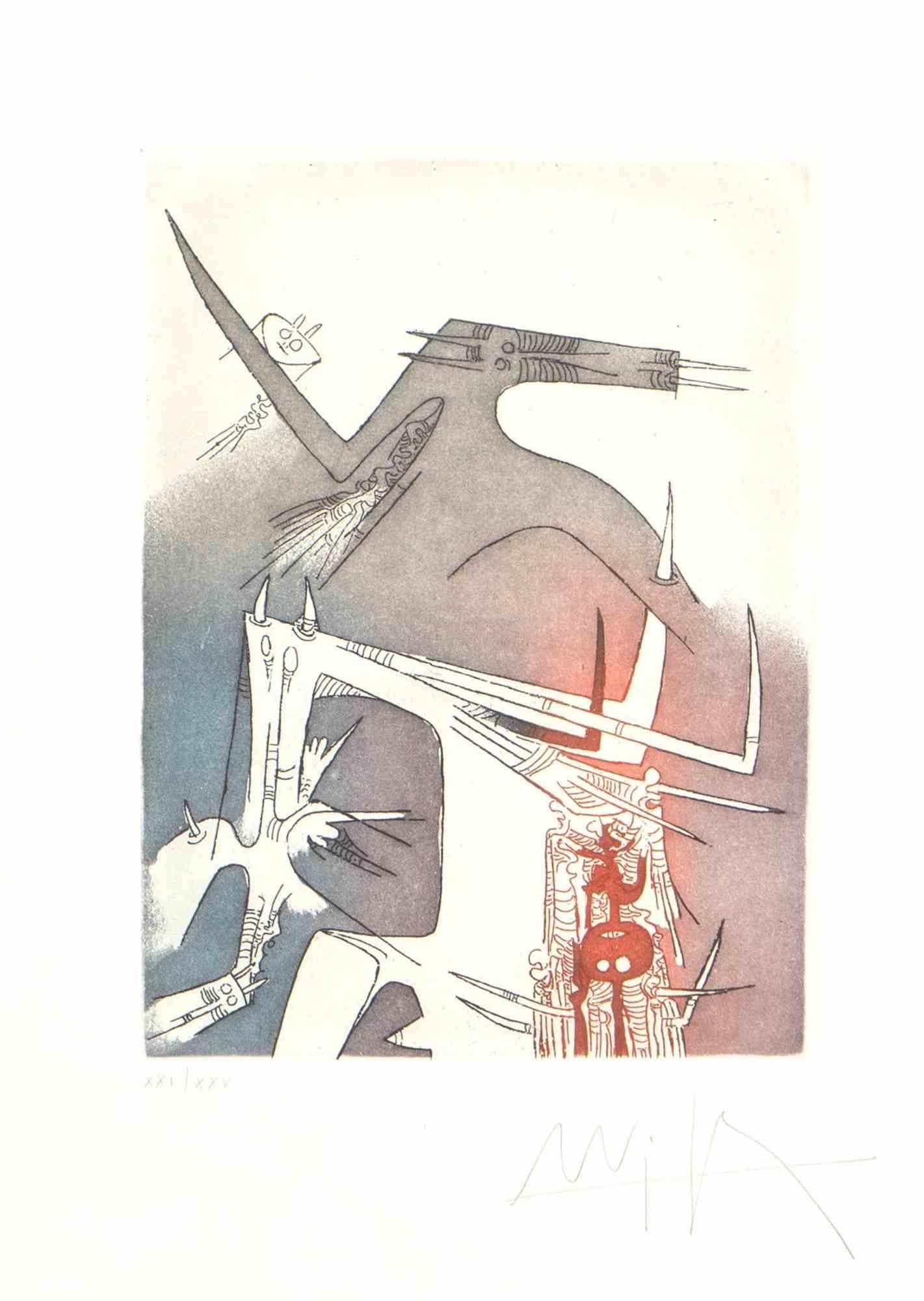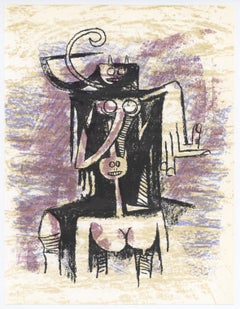Questions & Answers
Our trusted network of 1stDibs sellers answer common questions
Was Wifredo Lam a Surrealist?
1 Answer

Yes, Wifredo Lam was a Surrealist. After meeting André Breton, the author of the Surrealist Manifesto, the Cuban artist became highly involved with the Surrealist movement. He was also a member of the movement Négritude. Lam’s style resulted from his extensive travels, featuring graffiti-like flourishes with clear Cubist influences in a Surrealist mood. On 1stDibs, shop a variety of Wifredo Lam art.
1stDibs ExpertOctober 15, 2024
Related Questions
- What kind of art did Wifredo Lam make?1 Answer
- Was Cocteau a Surrealist?1 Answer
- What is a surrealist object?1 Answer
- Was Picasso a Surrealist?1 Answer
- Was Escher a Surrealist?1 Answer
Shop for Wifredo Lam on 1stDibs
original lithograph
By Wifredo Lam
Located in Henderson, NV
Medium: original lithograph. This Wifredo Lam surrealist print was issued in 1974 for XXe Siecle and published in Paris by San Lazzaro. Size: 12 1/4 x 9 3/8 inches (310 x 238 mm). No...
Category
1970s Surrealist Figurative Prints
Materials
Lithograph
"Les affinites ambigues" original lithograph
By Wifredo Lam
Located in Henderson, NV
Medium: original lithograph. Printed in 1963 for the art revue XXe Siecle and published in Paris by San Lazzaro. Size: 12 1/4 x 9 1/4 inches (312 x 235 mm). Not signed.
Category
1960s Surrealist Figurative Prints
Materials
Lithograph
Double Personage
By Wifredo Lam
Located in Fairlawn, OH
Double Personage
Color lithograph, 1975 (?)
Unsigned (as issued)
Edition: Large Edition Limited, (estimated to be approximately 2000)
Published in: XXe Siecle, No. 52, Juin 1979
Published: G. di San Lazzaro
Printer: Mourlot Imprimeur, Paris, France
Reference: Lam-Tonneau-Ryckelynck L7513
Condition: Excellent, fresh colors
Traces of glue residue along margin edge where it was bound in the book
Image/sheet size: 12 1/4 x 9 1/4 inches
Wilfredo Lam (1902-1982)
Biography
Wifredo Lam was born in Sagua la Grande, Cuba, on December 8, 1902. He was the eighth child born to Lam-Yam―born in Canton around 1820, an immigrant to the Americas in 1860―and to Ana Serafina Catilla―born in 1862 in Cuba of mixed African and Spanish ancestry.
The luxuriant nature of Sagua la Grande had a strong impact on Lam from early childhood. One night in 1907, he was startled by the strange shadows cast on the wall of his bedroom of a bat in flight. He often recounted the incident as his first magnificent awakening to another dimension to existence.
In 1916, Lam and part of his family settled in Havana. He was enrolled in the Escuela Profesional de Pintura y Escultura, Academia de San Alejandro, where he remained a student until 1923. This period, with exhibitions at the Salón de Bellas artes, was determinant in his choice to become a painter. In 1923, the municipality of Sagua la Grande awarded him a grant to study in Europe and by the autumn of that year, at the age of twenty-one, he left the country for Spain.
His time in Spain―initially intended as a short stay on his way to Paris―lasted 14 years. In Madrid, he was exposed to the ideas and movements of modern art. He spent long hours at the Archeological Museum and the Prado. He studied the great masters of Spanish painting, Velázquez and Goya, but felt particularly drawn to the works of Bosch and Bruegel the Elder. In 1931, his first wife, Eva (Sébastiana Piriz) and their son Wilfredo Victor died of tuberculosis. The terrible suffering he endured led to numerous paintings of mother and child. Lam found solace in the company of his Spanish friends and made contact with several political organizations. In 1936, with the help of his friend Faustino Cordón, he joined the Republican forces in their fight against Franco. He designed anti-Fascist posters and took part in the struggle by working in a munitions factory. The violence of the struggle inspired his painting La Guerra Civil.
In 1938, Lam left Spain for Paris. Shortly before leaving, he met Helena Holzer, who would become his wife in 1944. His meeting Picasso in his studio on the Rue des Grands Augustins proved decisive. Picasso introduced his new “cousin” to his painter, poet and art critic friends, Braque, Matisse, Miró, Léger, Eluard, Leiris, Tzara, Kahnweiler, Zervos. Lam also met Pierre Loeb, the owner of the Galerie Pierre in Paris, which hosted Lam’s first solo exhibition in 1939.
Shortly before the Germans arrived, Lam left Paris for Bordeaux and then Marseille, where many of his friends, for the most part surrealists, had gathered around André Breton in the Villa Air Bel: Pierre Mabille, René Char, Max Ernst, Victor Brauner, Oscar Domínguez, André Masson, Benjamin Péret. In the Villa Air Bel, a meeting place for creativity and experimentation, Lam worked and produced, most notably, a series of ink drawings that set the tone for what would become his signature style of hybrid figures, a vocabulary he would develop more fully during his years in Cuba from 1941 to 1947.
In January and February 1941, Lam illustrated Breton’s poem Fata Morgana which was censored by the Vichy government. On March 25, Lam and Helena Holzer embarked on the “Capitaine Paul Lemerle” headed for Martinique, in the company of some 300 other artists and intellectuals―André Breton and Claude Lévi-Strauss among them. Upon arrival, the passengers were interred at Trois Îles. It was during this forced passage in Martinique and before leaving for Cuba that Lam and Aimé Césaire met for the first time to become life-long friends.
Newly settled in his native land after almost twenty years, Lam delved deeper into his artistic investigations, finding nourishment for his ideas in the surroundings of his childhood and youth. His sister Eloisa, whom he was closest to, explained to him in much detail the workings of Afro-Cuban rituals and he began attending ritual ceremonies with some of his friends. This contact with Afro-Cuban culture brought new impetus to his art. He painted over one hundred canvases, most notably La Jungla, making the year 1942 his most productive of this period. Over the next few years, a number of exhibitions followed in the United States, at the Institute of Modern Art of Boston, at the MoMA of New York, at the Galerie Pierre Matisse, where La Jungla was presented and created a scandal.
In 1946, Lam and Helena travel to Haiti and attend voodoo ceremonies in the company of Pierre Mabille and André Breton. Talking about his experience in Haiti, Lam said, “It is often assumed that my work took its final form in Haiti, but my stay there, like the trips I made to Venezuela, Colombia or to the Brazilian Mato Grosso only broadened its scope. I could have been a good painter from the School of Paris, but I felt like a snail out of its shell. What really broadened my painting is the presence of African poetry.”
Picasso_Lam_Vallauris_1954_vignette
Wifredo Lam et Pablo Picasso, Vallauris, 1954
Lam then went on to New York where he renewed contact with Marcel Duchamp and made new acquaintances: Jeanne Reynal, James Johnson Sweeney, Arshile Gorky, John Cage, Roger Wilcox, Mercedes Matter, Ian Hugo, Jesse Fernández, John Cage, Sonia Sekula and Yves Tanguy. By the end of the 1940s, Lam divided his time between Europe, Havana and New York, where they stayed with Pierre and Teeny Matisse...
Category
1970s Surrealist Abstract Prints
Materials
Lithograph
Fresh Sketch - Red Ink Drawing by Wifredo Lam - 1970
By Wifredo Lam
Located in Roma, IT
Wonderful fresh sketch in red ink on an ivory-colored paper, with an autograph dedication "Per Pino Fasio amicia Pittore Wifredo Lam Albissola 1970" . Dated and signed in red ink. V...
Category
1970s Surrealist Figurative Drawings and Watercolors
Materials
Paper, Ink
Untitled - Lithograph by Wifredo Lam - 1960s
By Wifredo Lam
Located in Roma, IT
Untitled is a contemporary artwork realized by Wifred Lam.
Mixed colored lithograph.
Hand signed and numbered on the lower margin.
Edition of 5/30.
Some folds and signs of time, ...
Category
1960s Surrealist Figurative Prints
Materials
Lithograph
$670 Sale Price
30% Off
Wifredo Lam (7303) Taureau trois graines s est laisee pousser les dents, 1973
By Wifredo Lam
Located in Miami, FL
Wifredo Lam
(7303) Taureau trois graines s est laisee pousser les dents, 1973
Lithograph
EC
25 x 19 in
Category
1970s Modern Figurative Prints
Materials
Lithograph


